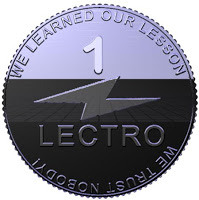“We cannot solve problems at the same level at which we created them.” — Albert Einstein
 |
| WRH image |
Eric Blair
Activist Post
A couple of weeks ago, a fresh idea for a new monetary system was quietly introduced that deserves more consideration. In fact, it’s an idea so profound that it could potentially solve some of the biggest problems facing human civilization. Increasingly the masses are becoming dreadfully aware that the current predatory monetary system is the greatest threat to human freedom, world peace, and environmental harmony, and must be abolished and replaced with something new.
The pioneering proposal is to create a monetary system based on electricity. Popular alternative news radio host and former NASA scientist, Michael Rivero, motivated by his knowledge and extreme displeasure of the current banking system, proposed the “Lectro”: a universal currency based on one kilowatt hour of electricity. Rivero writes:
What is needed is a medium for exchange that increases in supply right alongside the population itself, in order to maintain stability and constant value.
So, my suggestion is to use electricity as the universal basis for a new value-based money system. For the purposes of discussion I call the new US monetary unit the “Lectro.” It is redeemable for one kilowatt hour of electricity.
The Lectro provides a constant universal value, decentralizes money creation, encourages energy conservation and innovation, returns ownership of labor to the individual, cannot be monopolized or manipulated, and creates wealth instead of poverty during the transition from human labor to machine labor.
Until Rivero’s innovative idea, the monetary solutions debate has been in the trenches of “same level” thinking that created this mess in the first place. Some experts have argued for returning to a gold standard, while others prefer interest-free currency from the Treasury without a central bank. Incidentally, both sides are looking to past models for answers, each with merits and flaws.
Gold advocates argue that fiat currency (paper money backed by nothing) isn’t money because it has no commodity value, and critics of gold argue that it is a finite commodity and still can be manipulated in the hands of the few. The Lectro solves these concerns, and more — it has actual value, is decentralized, and its supply is infinite but organically controlled. With all due respect to the Constitution only permitting the use of gold and silver as legal payment, the document was written in free-hand, by candlelight — despite Ben Franklin’s best efforts to harness lightning with a kite. There was no way for the Founders, as brilliant as they were, to foresee a future with electricity. Yet, the philosophy behind using gold as money is the same as using electricity — it has a universally accepted value in society.
Mankind has used four types of money throughout history: commodity, receipt, fiat and fractional. Clearly, centrally controlled fiat and fractional money have proven to be one of humanity’s greatest tragedies. Gold and silver coins (commodity money) and receipts redeemable for 100% of gold on deposit (receipt money) have been considered by many to be the only true honest money system in history. Since electricity is not a “tangible” commodity, the Lectro currency would take the form of receipt money, redeemable for one kilowatt hour of power with the ability to be traded for any goods and services in the marketplace.
Rivero explains that the supply of Lectros could be created by anyone with the capacity to make electricity; therefore, money creation cannot be monopolized. When power is created, Lectros would flow into circulation and, as power is used and paid for, Lectros are taken out of circulation. This, he says, will make runaway inflation and speculation impossible while maintaining a supply directly controlled by free-market energy consumption.
Since there will be no debt or inflation built into the system, workers and businesses will never be chasing after an ever-increasing cost of living. This system would also seem to allow individuals to fully own their labor and ingenuity. Since incentives for energy conservation and innovation are byproducts of the system, everyone has the opportunity to participate and benefit. In other words, one could choose exactly what type of treadmill to figuratively or literally run on to acquire Lectros.
The exchange mechanism for this type of new currency does not require a middleman like a bank or clearinghouse. For electronic purchases, an algorithm similar to that of Bitcoin (a peer-to-peer electronic currency) may be implemented, where everyone has a private electronic wallet and Lectros can be traded from one wallet to another. Consequently, no one needs a bank account, just a wallet. Also following the Bitcoin model, the entire monetary system can be open source so that money creation is 100% transparent. Hard currency receipts can be encrypted and/or certified by the Treasury if necessary.
Perhaps the most important side-effect of such a system would be the benefit to the environment. Because inflation is inherent in the current monetary system, it demands constant “growth” in the economy to keep up. This is the mechanism responsible for rampant environmental destruction; but, with the Lectro, arbitrary growth is completely unnecessary. Lectros would be increased according to the electricity needs of the population. And, as stated before, the system would organically entice energy conservation and directly reward innovation. Rivero also suggests a tax, or maybe a reduced value for Lectros created with fossil fuels, and a higher value for Lectros derived from renewables.
Believe it or not, the future will have less stuff, but it will still be electrified. Already the iPhone has consolidated countless gadgets like phones, radios, cameras, video games, and Internet access into one handheld gadget. The new iPhone 5 concepts provide holograph keyboards and display screens. How fast will big TVs go extinct once our smart phones project 3D hologram images streamed live from the ether? Imagine the natural resources that will be saved because we won’t make Sony Walkmans, phone booths, CDs and DVDs, or TV’s anymore. However, this transition of consolidated technology means people will lose jobs in many industries, which is precisely why a new monetary system must account for this trend.
In the long term, creation of an energy-based money system will smooth the transition from a human-labor to machine-labor society. At present, human labor precedes all capital, payable in a monetary system that pays primarily for human labor. In switching to a monetary system that pays for machine based power production, we evolve towards a society where machines become the primary creators of capital, and all humans shift towards the demand side of the economy. Instead of creating poverty, the push towards automation creates more wealth.
Finally, many advocates for a new monetary system are motivated by their disgust of monopolistic control and manipulation of currency. This tends to result in an aversion to any one-world system for anything. However, the Lectro, given its universal value, could potentially be used as a global exchange mechanism, but with no central control. In turn, it has the potential to free all humans from servitude to debt, and begin to reverse environmental devastation from predatory economics.
We feel this out-of-the-box idea for a new monetary system must be discussed and analyzed in depth. An outline of tying electricity to the dollar can be found here and similar alternative currency can be found at KilowattCards.com. PLEASE begin the discussion in the comment section. Contact Michael Rivero here: rivero@hbentertain.com, (808-780-3788), WhatReallyHappened.com.
linkwithin_text=’Related Articles:’



Be the first to comment on "Electricity as the universal basis for a new money system"